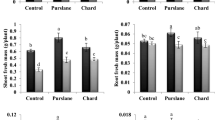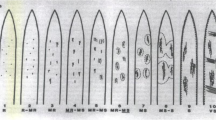Abstract
Application of foliar fungicides for the management of spot blotch of wheat in South Asia is needed when the weather is extremely conducive to disease progression. Field experiments were conducted during two consecutive years 2014–2015 and 2015–2016 to evaluate the effect of fungicides in late-sown wheat which suffers from the combined stress of terminal heat and spot blotch. Azoxystrobin (125 g a.i./ha) when applied twice (ZGS 50 and ZGS 60) and thrice (ZGS 40, 50 and 60) was comparable and gave the best control. In two sprays, the area under disease progress curve (AUDPC) was reduced to 161 compared to 763 under unprotected. Application of fungicide maintained the leaf area under greenness, chlorophyll content and normalized difference vegetative index (NDVI) up to physiological maturity. The canopy temperature (CT) was also reduced in fungicide-treated plots. The positive effect of fungicide on increased days to maturity (11.5 days) contributed significantly to thousand kernel weight (TKW) and grain yield. The fungicide appeared to balance the level of reactive oxygen species like hydroxyl radicals (OH−) and superoxide radicals (O2−), reducing membrane damage and increasing antioxidants like superoxide dismutase (SOD), catalase (CAT). The application of azoxystrobin appeared to manage the terminal heat stress through redox balance and reduced the spot blotch resulted in enhanced grain yield.


Similar content being viewed by others
Abbreviations
- AUDPC:
-
Area under disease progress curve
- SOD:
-
Superoxide dismutase
- MDA:
-
Malondialdehyde
- CAT:
-
Catalase
- SPAD:
-
Soil plant analysis development
- NDVI:
-
Normalized difference vegetative index
- TKW:
-
Thousand kernel weight
- CT:
-
Canopy temperature
- ZGS:
-
Zadoks growth stage
- LAUG:
-
Leaf area under greenness
References
Aebi HE (1983) Catalase. In: Bergmeyer HU (ed) Methods in enzymatic analysis. Academic Press, New York, pp 276–286
Apel K, Hirt H (2004) Reactive oxygen species: metabolism, oxidative stress, and signal transduction. Annu Rev of Plant Bio 55:373–399
Bertelsen JR, de Neergaard E, Smedegaard-Petersen V (2010) Fungicidal effects of Azoxystrobin and epoxiconazole on phyllosphere fungi, senescence, and yield of winter wheat. Plant Pathol 50:190–205
Butkutė B, Paplauskienė V, Gaurilčikieė I (2008) Efficacy of fungicide treatments on the winter wheat senescence, grain yield, protein concentration and yield. Zemdirb-Agric 95:242–250
Chand R, Yadav OP, Bashyal BM, Prasad LC, Joshi AK (2013) Technique for the maintenance of heterokaryotic isolates of Bipolaris sorokiniana. Indian Phytopathol 66:61–65
Cromey MG, Butler RC, Mace MA, Cole ALJ (2004) Effects of the fungicides Azoxystrobin and tebuconazole on Didymella exitialis, leaf senescence and grain yield in wheat. Crop Prot 23:1019–1030
Debona D, Rodrigues FA, Rios JA, Nascimento KJT (2012) Biochemical changes in the leaves of wheat plants infected by Pyricularia oryzae. Phytopathology 102:1121–1129
Dhindsa RH, Plumb-Dhindsa R, Thorpe TA (1981) Leaf senescence correlated with increased level of membrane permeability, lipid peroxidation and decreased level of SOD and CAT. J Exp Bot 32:93–101
Dimmock JPRE, Gooding MJ (2002) The effects of fungicides on rate and duration of grain filling in winter wheat. Crop Prot 21:475–487
Dubin HJ, Ginkel MV, Saunders DA (1991) The status of wheat diseases and disease research in warmer areas. In: Wheat for the nontraditional warm areas: proceedings of the international conference. Foz do Iguaçu, Brazil (pp 125-45). CIMMYT, July 29–Aug 3 1990
Feng B, Liu PL, Dong G, Wang ST, Kong FH, Zhang JW (2014) Effect of heat stress on the photosynthetic characteristics in flag leaves at the grain-filling stage of different heat-resistant winter wheat varieties. J Agron Crop Sci 200:143–155
Glaab LI, Kaiser WM (1999) Increased nitrate reductase activity in leaf tissue after application of the fungicide kresoxim-methyl. Planta 207:442–448
Grossmann KK, Witkowski J, Casper G (1999) Regulation of phytohormone levels, leaf senescence, and transpiration by the strobilurin kresoxim-methyl in wheat (Triticum aestivum). J Plant Physiol 154:805–808
Halliwell B, Gutteridge JM, Aruoma OI (1987) The deoxyribose method: a simple “test-tube” assay for determination of rate constants for reactions of hydroxyl radicals. Anal Biochem 165:215–219
Heath RL, Packer L (1968) Photo-oxidation in isolated chloroplast. I. Kinetics and stoichiometry of fatty acid peroxidation. Arch Biochem Biophys 125:189–198
Joshi AK, Ortiz-Ferrara G, Crossa J, Singh G, Sharma RC, Chand R, Prasad R (2007) Combining superior agronomic performance and terminal heat tolerance with resistance to spot blotch (Bipolaris sorokiniana) of wheat in the warm humid gangetic plains of South Asia. Field Crops res 103:53–61
Joshi AK, Kumari M, Singh VP, Reddy CM, Kumar S, Rane J, Chand R (2007) Stay green trait: variation, inheritance and its association with spot blotch resistance in spring wheat (Triticum aestivum L.). Euphytica 153:59–71
Lightfoot DJ, McGrann GRD, Able AJ (2016) The role of a cytosolic superoxide dismutase in barley-pathogen interactions. Mol Plant Pathol. https://doi.org/10.1111/mpp.12399
Lobell DB, Sibley A, Ortiz-Monasterio JI (2012) Extreme heat effects on wheat senescence in India. Nat Clim Change 2:186–189. https://doi.org/10.1038/nclimate1356
Luo P, Wu Ren Z, Zhang H, Zhang H, Feng J (2006) The structural and biochemical mechanism responsible for the stay-green phenotype in common wheat. Chin Sci Bull 51:2595–2603
Mercado D, Renard ME, Maraite H, Duveiller E (2003) Chlorophyll content and chlorophyll fluorescence as indicators of resilience to temperature stress in wheat and its relationship with resistance to Bipolaris sorokiniana. In: Rasmussen JB, Friesen TL, Ali S (eds) Proceedings of the international wheat tan spot and spot blotch workshop, pp 60–63. North Dakota State University, Bemidji, 21–24 July 2002
Merzlyak MK, Hendry GAF (1994) Free radical metabolism, pigment degradation and lipid peroxidation in leaves during senescence. Proc R Soc Edinb 102B:459
Misra HP, Fridovich I (1972) The role of superoxide anion in the autoxidation of epinephrine and a simple assay for superoxide dismutase. J Biol Chem 247:3170–3175
Netto AT, Campostrin IE, de Oliveira JG, Bressan-Smith RE (2005) Photosynthetic pigments, nitrogen, chlorophyll a fluorescence and SPAD-502 readings in coffee leaves. Sci Hort 104:2199–2209
Patterson BD, MacRae EA, Ferguson IB (1984) Estimation of hydrogen peroxide in plant extracts using titanium (IV). Anal Biochem 139:487–492
Pell EJ, Dann MS (1991) Multiple stress-induced foliar senescences and implications for whole-plant longevity. In: Mooney HA, Winner WE, Pell EJ, Chu E (eds) Response of plants to multiple stresses. Academic Press, New York, pp 189–204
Rawson HM, Hindmarsh JH, Fischer RA, Stockman YM (1983) Changes in leaf photosynthesis with plant ontogeny and relationships with yield per ear in wheat cultivars and 120 progeny. Funct Plant Biol 10:503–514
Reynolds M, Manes Y, Rebetzke G (2012) Application of physiology in breeding for heat and drought stress. In: Reynolds MP, Pask AJD, Mullan DM (eds) Physiological breeding I: interdisciplinary approaches to improve crop adaptation. CIMMYT, Texcoco, pp 18–32
Rosyara UR, Subedi S, Duveiller E, Sharma RC (2010) Photochemical efficiency and SPAD value as indirect selection criteria for combined selection of spot blotch and terminal heat stress in wheat. J Phytopathol 158:1813–1821
Rosyara UR, Vromman D, Duveiller E (2008) Canopy temperature depression as an indication of correlative measure for spot blotch resistance and heat tolerance. J Plant Pathol 90:103–107
Saari EE, Prescott JM (1975) A scale for appraising the foliar intensity of wheat diseases. Plant Dis Rep 59:377–380
Sahu R, Sharaff M, Pradhan M, Sethi A, Bandyopadhyay T, Mishra VK, Chand R, Chowdhury AK, Joshi AK, Pandey SP (2016) Elucidation of defense-related signaling responses to spot blotch infection in bread wheat (Triticum aestivum L.). Plant J 86:35–49. https://doi.org/10.1111/tpj.13149
Sedigheh HG, Mortazavian M, Norouzian D, Atyabi M, Akbarzadeh A, Hasanpoor K, Ghorbani M (2011) Oxidative stress and leaf senescence. BMC Res Notes 4:1
Shaner G, Finney RE (1977) The effect of nitrogen fertilization on the expression of slow-mildewing resistance in Knox wheat. Phytopathology 67:1051–1056
Shetty NP, Mehrabi R, Lütken H, Haldrup A, Kema GH, Collinge DB, Jorgenson HJL (2007) Role of hydrogen peroxide during the interaction between the hemibiotrophic fungal pathogen Septoria tritici and wheat. New Phytol 174:637–647
Singh PK, Zhang Y, He X, Singh RP, Chand R, Mishra VK, Malaker PK, Mostofa AR, Mokhlesur MA, Rahman RabiulIslam MRR, Chowdhury AK, Bhattacharya PM, Kalappanavar IK, Joshi AK (2015) Development and characterization of the 4th CSISA-spot blotch nursery of bread wheat. Eur J Plant Pathol 143:595–605. https://doi.org/10.1007/s10658-015-0712-x
Thorne GN (1982) Distribution between parts of the main shoot and the tillers of photosynthate produced before and after anthesis in the top three leaves of main shoots of Hobbit and Maris Huntsman winter wheat. Ann Appl Biol 101:553–559
Trippi VS, Gidrol X, Pradet A (1989) Effects of oxidative stress caused by oxygen and hydrogen peroxide on energy metabolism and senescence in oat leaves. Plant Cell Physiol 30:157–162
Wu YX, von Tiedemann A (2001) Physiological effects of azoxystrobin and epoxiconazole on senescence and the oxidative status of wheat. Pestic Biochem Physiol 71:1–10
Zadoks JC, Chang TT, Konzak CF (1974) A decimal code for the growth stages of cereals. Weed Res 14:415–421
Zhao H, Dai T, Jing Q, Jiang D, Cao W (2007) Leaf senescence and grain filling affected by post-anthesis high temperatures in two different wheat cultivars. Plant Growth Regul 51:149–158. https://doi.org/10.1007/s10725-006-9157-8
Acknowledgements
Authors are thankful to CGIAR—CRP—for financial support. SN is thankful to the Department of Science and Technology (DST), Govt. of India, for the INSPIRE fellowship [IF 150037] and ADAMA India for providing azoxystrobin.
Author information
Authors and Affiliations
Corresponding author
Additional information
Publisher's Note
Springer Nature remains neutral with regard to jurisdictional claims in published maps and institutional affiliations.
Rights and permissions
About this article
Cite this article
Navathe, S., Chand, R., Mishra, V.K. et al. Management of Spot Blotch and Heat Stress in Spring Wheat Through Azoxystrobin-Mediated Redox Balance. Agric Res 9, 169–178 (2020). https://doi.org/10.1007/s40003-019-00417-7
Received:
Accepted:
Published:
Issue Date:
DOI: https://doi.org/10.1007/s40003-019-00417-7




